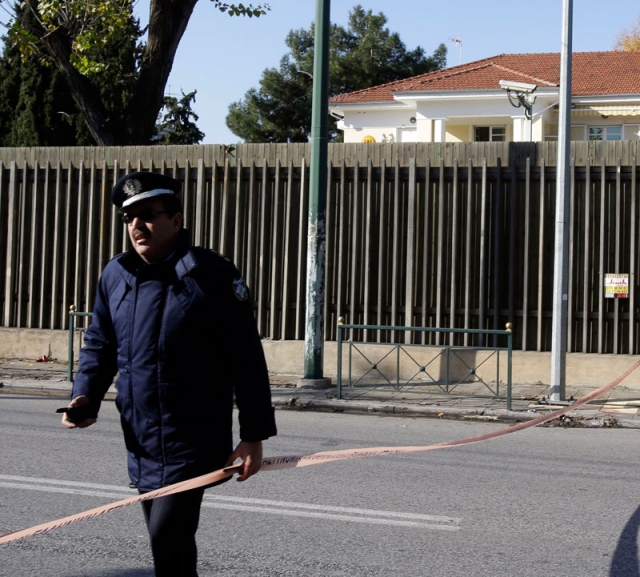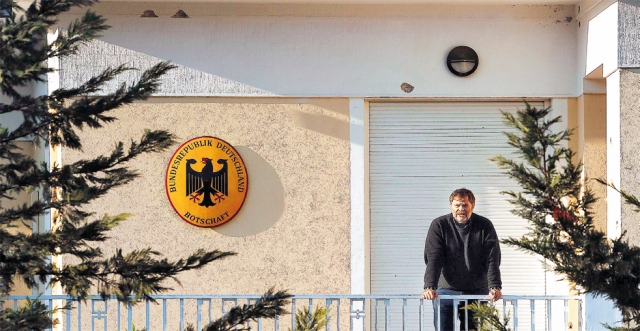Pictures: www.tovima.gr, www.tanea.gr
The leader of perpetrators of the armed attack, the testimony of a private security guard, the circle of involved organizations and disposable weapons, as well as the "history" of security arrangements at the residence of the Ambassador are the five reference points of the police in terms of the attack on the residence of the German Ambassador in Halandri on Monday morning.
To Vima presented them in detail:
First: the attention of the police is focused on a man dressed in black, aged over 35 with indistinct facial features who gave military orders to his accomplices.
The same person has been mentioned both by the guard, who was standing in front of the fence of the residence of the Ambassador and other witnesses who were shown photos of famous anarchists, and connections have been made on the basis of video recordings of recent bank robberies in the region, such as those in Methana, Nemea and Velestino. The "partial recognition" of a single person is also mentioned.

It is still not known how the four perpetrators arrived and escaped. The police are talking about "a well-organized attack which was absolutely successful and related to Germany's role in the economic crisis taking over the EU Presidency from Greece and Savas Ksiros’s request to be released from prison for health reasons.
It should be noted that since the connection with the security guard was interrupted as soon as he informed the police, there were serious concerns that he was badly injured.
Second: just behind the outer wall of the residence of the Ambassador, there was another security guard, an employee of a private security firm, who maintained the system of mobile cameras located inside and outside the building. Testimonies of the private security guards are considered very important.
Third: the Greek police are worried about the many attacks with unknown weapons such as the two Kalashnikovs used against the Ambassador's residence. This is indicative of the fact that new organizations are emerging, armed attacks cannot readily be distinguished from each other as regards the perpetrators, and arrested anarchists can avoid in this way a charge of complicity in armed groups and get only individual charges.
Investigators believe that there is a "central management and the same circle of people who have a large arsenal of weapons, creating organizations and carrying out attacks with disposable weapons." In 2013 alone, four new organizations emerged: Group of People's Fighters, Revolutionary Change, Military People's Revolutionary Forces and Cooperation of Anarchist Organizations.
The police are still gathering information about the involvement of criminals in one part of the guerrilla groups.

Fourth: It is known that the police have requested in recent years from the German diplomatic mission the construction of a high wall for safety around the residence - something which has not been accepted.
In parallel, those who are responsible for the security have requested the surveillance of 3-4 streets around the residence, through which the perpetrators of the last attack escaped. But that has not happened either.
After the attack on the Ambassador's residence by the organization "17 November" in May 1999, the building has been equipped with bulletproof glass, reinforced walls, and high resolution cameras have been installed. However, trees around the building have been trimmed, which probably facilitated offenders in terms of aiming at the building.
Senior police officers have often stated that there is a risk of a new attack against the residence because of the heavy and uncontrolled traffic of vehicles on Ethnikis Antistaseos Street in Halandri. The question of changing the place of residence of the Ambassador has also been raised, but this has not happened either.
Fifth: the police are talking about an attempt to imitate the 1999 attack against the same residence, when Savas Ksiros was injured.
It should be noted that in his statement of 27 May 1999, the then German Ambassador, Karl-Heinz Albert Kuhna, (who still lives in Greece) stated that he had seen a suspicious person with a brown hood, without glasses who looked like a photo of Theodoros Kolokotronis. One of the guards claimed that someone was following the movement of the Ambassador from a neighbouring balcony.
The examination of the blood, which was found at the site of the attack at the time, triggered a conflict between the police and German investigators, since forensic laboratories could not identify the DNA of the perpetrator quickly because of contamination with chlorophyll and foreign offices attributed the delay to the desire of Greek authorities to slow down the investigation.